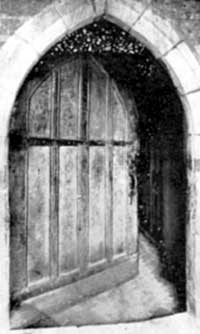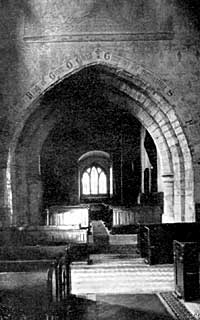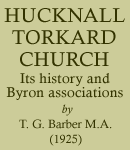HUCKNALL TORKARD CHURCH
ITS HISTORY

N the days of Edward the Confessor (1042-1066), so it is conjectured, a clearing was made in the forest of Sherwood for the erection of a Hall or Manor House, on a spot some 200 yards south west of the Church Tower.

The Church Door. 1320 A.D.
This Hall, which was of rude structure and small dimensions, gave its name to the hamlet which sprang up in this forest clearing. Tall and stately oaks surrounded the enclosures and common pastures adjoining the Hall, and so it came to be called "Oakenhall," or the "Hall in the Oaks." In Anglo-Saxon language the oak was sometimes called "Ac," and "Hack" and "Ock" were variations of the name. The change, therefore, from "Oakenhall" to "Hokenhall," and then "Hucknall," presents no difficulty. The suffix "Torkard " was the name of the Lord of the Manor at the time when the first little Church was built and dedicated to St. Mary Magdalene towards the end of the 12th Century.
The Churchyard was the burial place of the Parish until 1887, when the Cemetery was opened. It contains the bodies of the inhabitants of Hucknall Torkard for a period of over 700 years. The memorials to the dead are only of parochial interest.
The Porch at the main entrance to the Church was erected in 1320, when Thomas Torcard was Vicar of the Parish. Originally it was attached to the Nave. In 1872, when the South Aisle was built, it was moved stone by stone to its present position. Visitors will notice its ancient timber frame which for six centuries has defied both wear and weather. The Porch was at one time protected by gates. In the centre beam may be seen the hole into which the gate-bolt was shot.
The Old Oak Door is of the same date. A careful examination of its surface will reveal that it was fashioned with axe and adze.

The 14th Century Font.
The Baptistry.—Upon entering the Church the visitor will notice the Baptistry on the left, which was an addition to the Church in 1871-72. It contains the old Octagonal Font of the 14th century, and a stained glass window by Mr. Kempe. Twenty-five of the stained glass windows in the Church are his work. The window in the Baptistry is a very fine specimen of his art. It is a copy of the window which he designed for the Princess Alice in memory of her child, who met with a fatal accident by falling from the Castle Balcony in Hesse Darmstadt.
The Tower.—The lower portion of the Tower, with its beautiful transitional Arch, is the only part of the original structure remaining. This was built about the year 1180. One hundred and forty years later—1320—the Tower was carried to its present height.
The hatchment on the Tower Wall carrying the Byron Arms originally hung in the Chancel. It was probably the gift of a member of the Byron family.
The Clock, with its four dials, was the gift of the Duke of Portland in 1884. It replaced an older clock of rude construction, which had done service for nearly 140 years.
The Bells are three in number.

The Tower Arch. 1180 A.D.
The treble bell, the oldest of the three, was, it is conjectured, once at Newstead Abbey. It may have been placed in the Tower by the Prior of Newstead, who was Patron of the Living in 1320 when the Belfry was built. It bears the inscription "Ave Maria," and was probably used for ringing the "Angelus."
The tenor bell was placed in the Tower in the 17th Century. It was cast in George Oldfield's foundry, Nottingham, in 1639. For nearly three centuries it has rung out the prayer inscribed upon it —"God Save the Church!
The third, or bass bell, was added a little more than a century later — 1749. The name of the Churchwarden at the time—"Theophilus Allcock," —is inscribed upon it.
Just beyond the Tower Arch the visitor will see upon the Tower wall an incised slab, which at one time marked the grave of a woolstapler, as the weight and shears indicate.
The Nave. — No trace of the original Nave remains. The early structure was in all probability pulled down, and the present Nave, with the exception of the Clerestory, built in 1320.
The North Aisle was constructed at the same time. It was restored and altered 150 years later, when the old 14th century lights were replaced by the present perpendicular windows.
The two mural tablets represent the "Return of the Prodigal" and "Praise." For these tablets, the tablet over the main door, the linoleum paintings, and the diaperwork on the walls of the Chancel and Nave, the Church is indebted to the generosity of Canon Godber, who died in 1906. The slate slab on the wall bears the name of John Curtis, who died July 10, 1777aged 80, "whose ancestors, as appears by ancient writings, have resided in this Township upwards of 500 years." The names of his wives, Ann and Elizabeth, are inscribed on the same tablet. The two stained glass windows represent "The Creation."
The South Aisle was built in 1871-2. The subjects of the stained glass windows are Christ's appearance after the Resurrection to the Disciples on the Sea of Galilee, and the healing of the lame man by St. Peter and St. John at the Beautiful Gate of the Temple. The former was the gift of the parishioners as a grateful acknowledgment of the many benefactions of the Rev. Canon Godber. The latter was the gift of Charlotte Widdowson, in memory of her husband James, who was for 30 years Churchwarden of this Parish. The marble tablet on the wall records the death of Elizabeth Sarah, daughter of John and Elizabeth Godber, of Whyburn House, who died in 1856.
